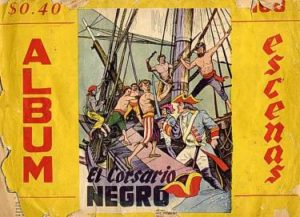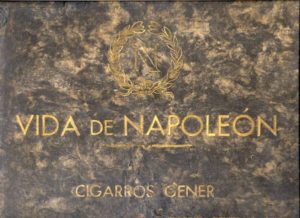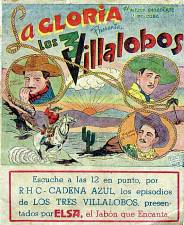LAS NUNCA OLVIDADAS “POSTALITAS” CUBANAS.
Las famosas postalitas fueron gran parte del entretenimiento de la juventud cubana. A simple vista sólo parecían postalitas, pero ahora que no existen, mirándolas desde una perspectiva más amplia, de juego no tenían nada. Un mundo maravilloso donde tal vez se aprendiera una cosita o dos, o al menos, un rato de distracción. Sin lugar a dudas, las postalitas fueron gran parte de la cultura juvenil cubana.
Ya en las décadas de 1940 hasta principios de 1960, casi siempre había una serie de postalitas a la venta. El tema usualmente estaba relacionado con algún programa de radio, después de televisión, siendo los temas tan variados a como la imaginación permite. Algunas series tenían cierto valor educacional, otras, la verdad que no. Sin embargo, todas eran fascinantes porque no sólo se coleccionaban, también se intercambiaban y sobre todo, servían para jugar a las postalitas.
Por lo general cada serie tenía un álbum y las postalitas, aunque nos parece recordar algunas series que no tuvieron álbum, pero bueno. Muy similar a los cromos europeos, que también se vendieron en Cuba, excepto que en el caso de los cromos se compraba el álbum y los cromos en un paquete, todo junto. En las postalitas el álbum se compraba por sí solo, y las postalitas se vendían en pequeños sobrecitos que contenían unas cinco postalitas cada uno.
Cada serie consistía de una cantidad de postalitas determinada. Cada postal, de papel o cartulina, tenía una imagen relacionada con el tema de la serie; podían ser dibujos o fotos. En algunas series las postalitas sólo tenía en común el tema general de la serie, como en el caso del Zoológico donde son presentadas especies de animales sin tener gran relación con la especie de la postalita anterior o siguiente. En otras series las postalitas mantenían una secuencia, digamos el desarrollo de una aventura. Lo importante es que todas las postalitas estaban enumeradas y de tal forma tenían un valor relativo en la serie.
Entonces salían a la venta en grupos. Digamos, en una serie de doscientas postalitas, unos treinta números salían primero. No tenían que ser los números más bajos, ni tampoco seguidos. Después salía otro grupo similar y así hasta que eventualmente todas llegaban a poder tenerse.
Había veces que desde que salía el primer grupo a que el último grupo viera el mercado pasaban meses. Mientras tanto los muchachos se pasaban el tiempo tratando de coleccionar todos los números que ya estaban disponibles y pegar las postalitas en el álbum, si es que el álbum ya estaba a la venta. Las repetidas se intercambiaban, pero lo más normal era que se usaran para jugar a las postalitas. Algo así como jugar a las cartas, sólo que se apostaban las mismas postalitas.
Pero las postalitas cubanas tienen mayor trascendencia. A principios del siglo XX a una casa de cigarrillos, los cigarrillos Susini, se le ocurrió poner una postalita dentro de cada cajetilla. Como es de esperar, se empezaron a coleccionar. La casa Susini también editó álbumes donde pegar tales postalitas. Como vemos en los álbumes, al principio no tenían mucha coherencia, siendo el tema de la serie no bien definido del todo. Poco después editaron al menos dos series que son verdaderas obras de arte; no sólo por su valor artístico, que es excelente, sino por la información que proveen tanto las imágenes como el texto en el álbum.
También hemos logrado encontrar un álbum de postalitas, Vida de Napoleón, muy similar a los de Susini, pero indica ser de los cigarros Gener. No sabemos si Susini y Gener estaban relacionados, pero aparentemente la idea tuvo serios resultados.
Esperamos que este pequeño detalle de la cultura cubana, que tanto educó y entretuvo sanamente a la juventud cubana le sea de tanto agrado como lo fue y continúa siendo para nosotros.
THE NEVER FORGOTTEN CUBAN “POSTALITAS”.
The famous postcards were much of the entertainment of Cuban youth. At first glance they only looked like postcards, but now that they do not exist, looking at them from a wider perspective, they had nothing to play with. A wonderful world where you might learn a little thing or two, or at least a bit of distraction. Undoubtedly, the postcards were a large part of Cuban youth culture.
Already in the 1940s until the early 1960s, there was almost always a series of postcards on sale. The subject usually was related to some radio program, after television, being the subjects as varied as the imagination allows. Some series had some educational value, others, not really. However, they were all fascinating because they were not only collected, exchanged and above all, used to play the postcards.
Each series consisted of a certain number of postcards. Each postcard, of paper or cardboard, had an image related to the theme of the series; Could be drawings or photos. In some series the postcards had only in common the general theme of the series, as in the case of the Zoo where are presented species of animals without having great relation with the species of the previous or next postcard. In other series the postalitas maintained a sequence, say the development of an adventure. The important thing is that all the postcards were listed and so had a relative value in the series.
Then they went on sale in groups. Let’s say, in a series of two hundred postcards, about thirty numbers came out first. They did not have to be the lowest numbers, or even followed. Then another similar group came out and so on until eventually they all came to be.
There were times since the first group came out that the last group saw the market spend months. Meanwhile, the boys spent their time trying to collect all the numbers that were already available and paste the postcards into the album, if the album was already on sale. The repeated ones were exchanged, but the most normal thing was that they were used to play to the postcards. Something like playing cards, only the same postcards were bet.
But Cuban postcards are more important. In the early twentieth century a cigarette house, Susini cigarettes, he thought to put a postcard inside each pack. As expected, they began to collect. The Susini house also published albums to paste such postcards. As we see in the albums, at first they did not have much coherence, being the subject of the series not well defined at all. Shortly afterwards they published at least two series that are true works of art; Not only for its artistic value, which is excellent, but for the information provided by both the images and the text in the album.
We have also managed to find an album of postcards, Life of Napoleon, very similar to those of Susini, but it indicates to be of the Gener cigars. We do not know if Susini and Gener were related, but apparently the idea had serious results.
We hope that this small detail of the Cuban culture, which educated and entertained healthily the Cuban youth is as pleasing as it was and continues to be for us.
Agencies/ElGuije/Internet Photos/Arnoldo Varona/TheCubanHistory.com
THE CUBAN HISTORY, HOLLYWOOD.










